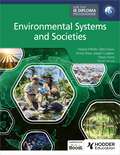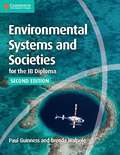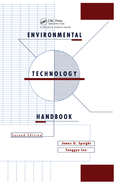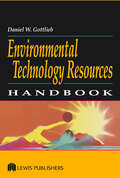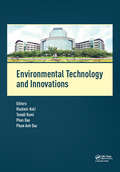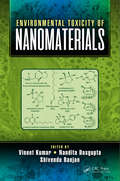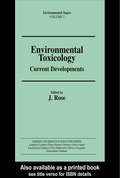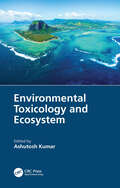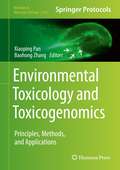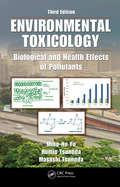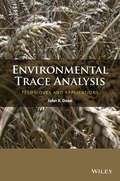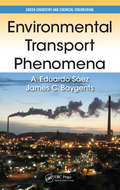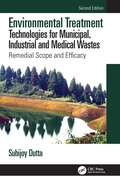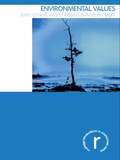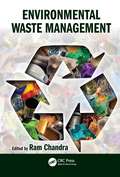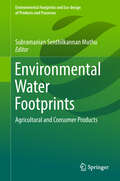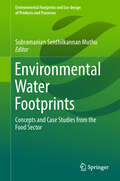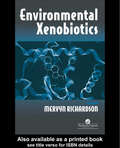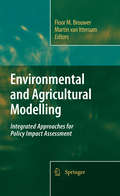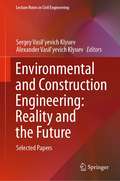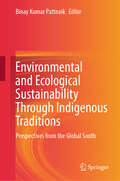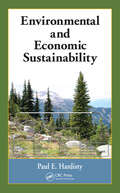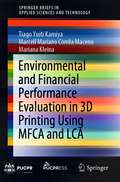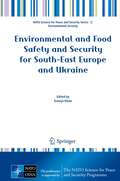- Table View
- List View
Environmental Systems and Societies for the IB Diploma (For the IB Diploma)
by Virginia D'Britto Öykü Dulun Emma Shaw Joseph CazabonDeveloped in cooperation with the International Baccalaureate® Ensure full coverage of the updated syllabus with a coursebook that implements inquiry-based and conceptually-focused teaching and learning, written by highly experienced global authors. - Explore the three key concepts in the new course: perspectives, systems and sustainability which allow students to deepen their understanding and make interdisciplinary connections throughout, with HL content clearly signposted. - Prepare students for assessment with a range of options: exam-style questions, top tip boxes and hints to help avoid common mistakes. - Integrate TOK into lessons and create opportunities for cross-curriculum study with case studies, real world examples and up-to-date data. - Provide plenty of practise with activities, review questions and chapter summaries allowing students to recap themes and test knowledge. - Enable students to feel confident in course terminology with ESL support, definitions, key terms and a glossary.
Environmental Systems and Societies for the IB Diploma (IB Diploma Series)
by Brenda Walpole Paul GuinnessThis book covers the syllabus for the IB Diploma Programme Environmental Systems and Societies, which is offered at Standard Level only. Our understanding of the environment and its importance to our lives has grown rapidly over recent decades and the Environmental Systems and Societies course
Environmental Technology Handbook: 2nd Edition (Applied Energy Technology Ser.)
by James G SpeightHistorically, the development of civilization has upset much of the earth’s ecosystem leading to air, land, and water pollution. The author defines pollution as the introduction of a foreign substance into an ecosystem via air, land or water. This book delves into issues that effect the everyday lives of people who come in contact with these hazards. By examining these issues, this body of work aims to stimulate debate and offer solutions to the ever-growing threat to the environment and humanity. Includes problems with each chapter, Explores issues such as control of gaseous emissions, waste recycling and waste disposal, Explains physical and thermal methods of waste management, Provides definitions and resources for future reference, Discusses the history of environmental technology.
Environmental Technology Resources Handbook
by Daniel W. GottliebThis handbook guides the user to hundreds of technologies, practices, partnership opportunities, and funding resources. Presented in non-technical language, it covers hundreds of publicly available resources for pollution prevention, control, remediation, and assessment. Environmental Technology Resources Handbook will help you:
Environmental Technology and Innovations: Proceedings of the 1st International Conference on Environmental Technology and Innovations (Ho Chi Minh City, Vietnam, 23-25 November 2016)
by Vladimír Kočí, Tomáš Ruml, Phan Dao & Pham Anh DucThis book covers a wide range of topics within enviromental engineering and technologies including: • General environmental engineering• Clean energy and sustainability• Water and wastewater management• Public health and environment. The application areas range from emerging pollutants of air, soil and water environment, remediation technologies, clean energy and sustainability of biofuels, waste to energy, water and wastewater management, public health and the environment, quality and safety of food production to environmental planning and management and policies for cities and regions. The papers cover both theory and applications, and are focused on a wide range of sectors and problem areas. Integral demonstrations of the use of reliability and environmental engineering are provided in many practical applications concerning major technological approaches. Environmental Technology and Innovations will be of interest to academics and professionals working in a wide range of industrial, governmental and academic sectors, including water and waste management, energy generation, fuel production and use, protection of natural heritage, industrial ecology, man health protection and policy making.
Environmental Toxicity of Nanomaterials
by Vineet Kumar Shivendu Ranjan Nandita DasguptaEnvironmental Toxicity of Nanomaterials focuses on causes and prevention of environmental toxicity induced by various nanomaterials. In sixteen chapters it describes the basic principles, trends, challenges, and future directions of nanoecotoxicity. The future acceptance of nanomaterials in various industries depends on the impacts of nanomaterials on the environment and ecosystem. This book analyzes the safe utilization of nanotechnology so the tremendous prospect of nanotechnology can be achieved without harming either living beings or the environment. Environmental Toxicity of Nanomaterials introduces nanoecotoxicity, describes various factors affecting the toxicity of nanomaterials, discusses various factors that can impart nanoecotoxicity, reviews various studies in the area of nanoecotoxicity evaluation, and describes the safety and risk assessment of nanomaterials. In addition, the book discusses strategies for mitigating nanoecotoxicity. Lastly, the authors provide guidelines and protocols for nanotoxicity evaluation and discuss regulations for safety assessment of nanomaterials. In addition to environmental toxicologists, this book is aimed at policy makers, industry personnel, and doctoral and postdoctoral scholars.
Environmental Toxicology
by Edward A. LawsEnvironmental Toxicology provides a detailed, comprehensive introduction to this key area of sustainability and public health research. The broad coverage includes sections on ecological risk assessment, monitoring, mechanisms, fate and transport, prevention, and correctives, as well as treatment of the health effects of solar radiation and toxicology in the ocean. The 23 state-of-the-art chapters provide a multi-disciplinary perspective on this vital area, which encompasses environmental science, biology, chemistry, and public health.
Environmental Toxicology
by J. RoseBecause our chemical environment affects our physical and mental well-being, it is a matter of increasing concern and is therefore attracting much research effort. This timely collection of essays highlights current developments in the field of environmental toxicology. Chapters analyze the carcinogenic, mutagenic, genotoxic, and neurotoxic effects
Environmental Toxicology and Ecosystem
by Ashutosh KumarThis book covers varied aspects of environmental contaminants and their effect on the living organisms. It addresses the basics of ecotoxicity assessment, interaction of the abiotic or biotic factors with the novel chemical entities, and the fate of the natural organic matter upon interaction with new chemical entities. It further includes models for ecotoxicity studies and high-throughput approaches including OMICS. It provides an overview of the ecological risk assessment, regulatory toxicology guidelines, and possible roadmaps for protection of environmental health. Features: Discusses environmental toxicology facets and their effects on the ecosystem. Provides an introduction of environmental toxicology keeping in view the paradigm shift on entry of novel materials in the environment. Includes bioavailability, bioconcentration, and biomagnification of trophic transfer of pollutants. Covers high-throughput approaches for ecotoxicity assessment. Explores roadmaps for environmental protection and sustainable development. This book is geared toward graduate students and researchers in Environmental Sciences and Engineering, Toxicology, and Ecology.
Environmental Toxicology and Toxicogenomics: Principles, Methods, and Applications (Methods in Molecular Biology #2326)
by Baohong Zhang Xiaoping PanThis detailed book provides an accessible compendium of up-to-date methods in the fields of environmental toxicology, molecular toxicology, and toxicogenomics. Organized into four major sections, the volume examines methods utilizing model animal species, such as nematode, fruit fly, mice, chicken, and amphibians, methods using plants to study chemical toxicity, applying the Ames assay to chemical mutagenicity study, as well as methods for environmental chemical analysis. Although this book is divided into these parts, the methods can be used across species. Written for the highly successful Methods in Molecular Biology series, chapters include introductions to their respective topics, lists of the necessary materials and reagents, step-by-step, readily reproducible laboratory protocols, and tips on troubleshooting and avoiding known pitfalls. Authoritative and practical, Environmental Toxicology and Toxicogenomics: Principles, Methods, and Applications serves as a valuable resource for the scientific community, particularly for young scientists and graduate and undergraduate students, inspiring more research in the vitally important field of environmental toxicity, molecular toxicology, and toxicogenomics.
Environmental Toxicology: Biological and Health Effects of Pollutants, Third Edition
by Ming-Ho Yu Humio Tsunoda Masashi TsunodaHuman survival depends on the availability of clean air, water, and food and on the welfare of plants and animals. However, anthropogenic and naturally occurring chemicals can cause adverse effects on living organisms and ecological processes. Environmental Toxicology: Biological and Health Effects of Pollutants, Third Edition presents fundamental
Environmental Trace Analysis
by John R. DeanThis book covers all aspects of environmental trace analysis from sampling through to preparation of the sample to the analytical techniques used to quantify the level of trace metals or organic compounds. The book is divided into two areas: sample preparation for inorganic analysis and sample preparation for organic analysis. This allows the reader to focus on key aspects related to the preparation of samples for their subsequent analysis. Selected case studies provide the reader with the opportunity to consider how the sample preparation approach can be optimized for their own area of expertise.
Environmental Transport Phenomena (ISSN)
by A. Eduardo Saez James C. BaygentsThis book offers a detailed yet accessible introduction to transport phenomena. It begins by explaining the underlying principles and mechanisms that govern mass transport, and continues by tackling practical problems spanning all subdisciplines of environmental science and chemical engineering. Assuming some knowledge of ordinary differential equations and a familiarity with basic fluid mechanics applications, this classroom-tested text addresses mass conservation and macroscopic mass balances, placing a special emphasis on applications to environmental processes and presenting a mathematical framework for formulating and solving transport phenomena problems.
Environmental Treatment Technologies for Municipal, Industrial and Medical Wastes: Remedial Scope and Efficacy
by Subijoy DuttaEnvironmental Treatment Technologies for Municipal, Industrial and Medical Wastes will provide the reader with a simple and clear path to analyze the full range of options to manage/treat any solid, hazardous, or medical waste problems/issues at hand. This book aims to disseminate information on available remediation treatment technologies to developing and developed countries. It also includes adequate information on all available treatment technologies for different types and categories of waste (hazardous, non-hazardous municipal solid waste, and medical waste). The technologies are grouped into the following categories: Containment technology; Soil washing; Thermal treatment; Vapor extraction; Bioremediation including Phytoremediation; Plasma/Incineration; Other Physical/Chemical treatments. It enlightens the effect of emissions during remediation activities on climate change and suggests measures to identify and control such emissions. It also covers the application of remote sensing technologies with examples and the impending issues of proper disinfection and disposal of COVID-19 related waste pertaining to the current pandemic. It is intended for almost anyone — ranging from college students and early career professionals interested in environmental pollution control, to graduate students, researchers and experienced professionals. This book will: cover several recent developments on various treatment technologies, including in situ applications and their emission/migration control methods including remote sensing technologies; deal with municipal solid waste, their treatment/disposal methods, recycling, and reuse in addition to the hazardous and medical waste management program; assist civil/environmental engineering students and local community organizations in evaluating the impact of an industry and its associated waste produced on-site; and cover how best to treat/manage the waste to arrive at a safe operation without impacting human health and the local environment.
Environmental Values
by Andrew Light John O'Neill Alan HollandWe live in a world confronted by mounting environmental problems; increasing global deforestation and desertification, loss of species diversity, pollution and global warming. In everyday life people mourn the loss of valued landscapes and urban spaces. Underlying these problems are conflicting priorities and values. Yet dominant approaches to policy-making seem ill-equipped to capture the various ways in which the environment matters to us. Environmental Values introduces readers to these issues by presenting, and then challenging, two dominant approaches to environmental decision-making, one from environmental economics, the other from environmental philosophy. The authors present a sustained case for questioning the underlying ethical theories of both of these traditions. They defend a pluralistic alternative rooted in the rich everyday relations of humans to the environments they inhabit, providing a path for integrating human needs with environmental protection through an understanding of the narrative and history of particular places. The book examines the implications of this approach for policy issues such as biodiversity conservation and sustainability. Written in a clear and accessible style for an interdisciplinary audience, this volume will be ideal for student use in environmental courses in geography, economics, philosophy, politics and sociology.
Environmental Waste Management
by Ram ChandraRapid industrialization has resulted in the generation of huge quantities of hazardous waste, both solid and liquid. Despite regulatory guidelines and pollution control measures, industrial waste is being dumped on land and discharged into water bodies without adequate treatment. This gross misconduct creates serious environmental and public health
Environmental Water Footprints: Agricultural and Consumer Products (Environmental Footprints and Eco-design of Products and Processes)
by Subramanian Senthilkannan MuthuThis book uses case studies to highlight the environmental water footprints in the agricultural and livestock farming sector, and those of consumer products. Water conservation is a major element of every industry’s sustainability strategy.
Environmental Water Footprints: Concepts And Case Studies From The Food Sector (Environmental Footprints And Eco-design Of Products And Processes)
by Subramanian Senthilkannan MuthuThis book discusses the concept of water footprint and corporate water footprint, presenting case studies on a thermal power plant in India and on the food sector. Water conservation is a key element of industrial sustainability strategies.
Environmental Xenobiotics
by Mervyn RichardsonThe effects of man-made substances (xenobiotics) on the natural environment are described in this volume. It explains why these effects need to be understood, monitored and curtailed, especially in developing countries.
Environmental and Agricultural Modelling:
by Martin Van Ittersum Floor M. BrouwerAgriculture increasingly faces the challenge of balancing its multiple functions in a sustainable way. Integrated assessment and modelling (IAM) can provide insight into the potential impacts of policy changes. However, concepts to address the wide range of issues and functions typical for agriculture are still scarce. Environmental and Agricultural Modelling reviews and presents our current understanding of integrated and working tools to assess and compute, ex-ante, alternative agricultural and environmental policy options, allowing: 1. Analysis at the full range of scales (farm to European Union and global) whilst focusing on the most important issues emerging at each scale; 2. Analysis of the environmental, economic and social contributions of agricultural systems towards sustainable rural development and rural viability; 3. Analysis of a broad range of issues and agents of change, such as climate change, environmental policies, rural development options, effects of an enlarging EU, international competition, and effects on developing countries.
Environmental and Construction Engineering: Selected Papers (Lecture Notes in Civil Engineering #160)
by Sergey Vasil’yevich Klyuev Alexander Vasil’yevich KlyuevThis book gathers the latest advances, innovations, and applications in the field of construction engineering, as presented by researchers and engineers at the International Conference Environmental and Construction Engineering: Reality and the Future, held in Belgorod, Russia, on May 18-19, 2021. It covers highly diverse topics, including industrial and civil construction, building materials; environmental engineering and sustainability; machines, aggregates and processes in construction. The contributions, which were selected by means of a rigorous international peer-review process, highlight numerous exciting ideas that will spur novel research directions and foster multidisciplinary collaborations.
Environmental and Ecological Sustainability Through Indigenous Traditions: Perspectives from the Global South
by Binay Kumar PattnaikThis book explores the environmental and ecological wisdom inherent in some of the indigenous traditions of traditional communities from developing societies like, Argentina, Brazil, India, Mexico, Sri Lanka, and Thailand. It throws light on how these discrete and unrecognized traditions have enabled communities to live in harmony with nature for ages. Despite the best efforts of the modern states through policy-making, intensive R&D for eco-friendly technologies and products, social and environmental impact assessment studies (SEIAS), and cost benefit analysis (CBA) of projects, environmental and ecological degradation continues, mostly in developing societies, which house large number of traditional communities. This book explores their traditions consisting of world views or cosmologies, eco-savvy-customs, indigenous knowledge systems involving community-based occupations and practices, skills and crafts, and so on. This book shows that when interpreted in consonance with scientific environmentalism, these traditions reveal their inbuilt environmental wisdom, mirroring sacredness of nature that have instilled built-in conservation practices, are key to sustainability.The conception of indigenous traditions that subsume environmental and ecological sustainability as well as cultural identity is studied in the book, from the vantage of multi-disciplinary perspectives. This book reflects two streams of thought : (i) stream of social anthropology, arguing for the inbuilt strength of indigenous traditions, that necessitate empathetic understanding with their own rights for recognition and survival, and (ii) stream of indigenous knowledge systems being technically effective only necessitate validation and certification by modern scientific knowledge system for wider use. The book is of great use to policy-makers and non-government players, in addition to researchers and academicians working in the area of sustainable development and indigenous / traditional communities.
Environmental and Economic Sustainability
by Paul E. HardistyNever before has the quest to balance the needs of people, the environment, and the economy been so important. While sustainability has been widely taken up by governments and business, the world has continued to move in increasingly unsustainable directions, from continued dependence on fossil energy to rising greenhouse gas emissions, and erosion
Environmental and Financial Performance Evaluation in 3D Printing Using MFCA and LCA (SpringerBriefs in Applied Sciences and Technology)
by Tiago Yuiti Kamiya Mariana Kleina Marcell Mariano Corrêa MacenoThis book presents the methodology of environmental and financial performance evaluation in 3D printing processes using the MFCA and LCA. This methodology is divided into 7 main steps, which are: a) identification of the analysis problem (for example, comparison of different types of 3D printer for use in a given purpose, comparison of different printing materials for the same 3D printer technology, among others) and definition of printing parameters; b) definition of the product to be printed; c) preparation of the printing process flow diagram; d) definition or measurement of the lifespan of the printed product; e) data collection for the implementation of the LCA tool (for example, mass and energy balances); f) data collection for the implementation of the MFCA tool (for example, mass balances, energy balances, mass costs, energy costs, labor costs, etc.); and g) comparative assessment of the financial and environmental performance of 3D printing. As a way of exemplifying the application of this methodology, a real case is presented involving the comparison of two types of materials (Polylactic Acid – PLA – and Polyethylene Glycol Polyterephthalate – PETG) used in the 3D printing process by FDM technology. The part printed in this real case was a clearance gauge used as a joint spacing control by an automobile industry located in Brazil. The development of the methodology and consequent application has shown that it can be used by users of 3D printing, in the most diverse areas, to support their decision in choices that can present the best performance, both financial and environmental.
Environmental and Food Safety and Security for South-East Europe and Ukraine
by Ksenija VitaleThis book covers important aspects of the field of food security and safety, ranging from fundamental production, through advanced water treatment technologies and detection of novel pollutants, to management and policy making. The discussion strives to develop an integrated approach to solving the associated problems by simultaneously considering sociological, ecological and economic aspects. Special focus is on the environmental management systems that should be integrated in the processes of environmental risk assessment. Also addressed are other technologies applied in the service of detecting, preventing and monitoring possible threats to food security and safety. With its variety of subjects, this volume can serve both as a textbook for advanced studies and as a useful reference source for professionals.
